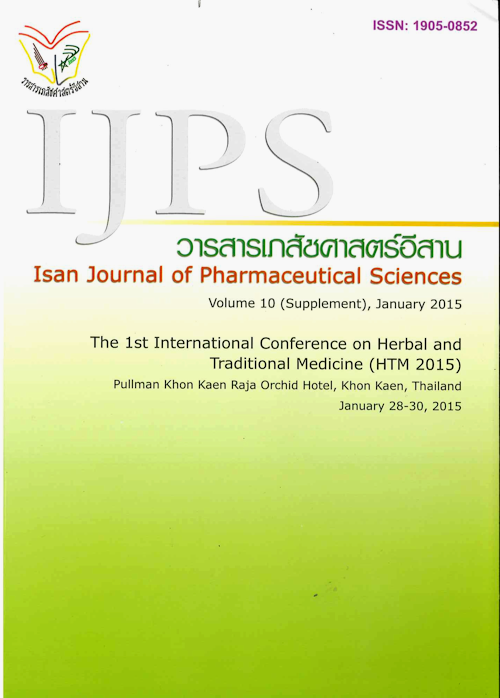Relationship between Lactose and Microcrystalline Cellulose as Diluents on Physical Characteristics of Banana Extract Tablet using Computer Program
Main Article Content
Abstract
Introduction: The utilization of banana in pharmaceutics has gained attention as an alternative
excipient for tablet formulation. Banana starch obtained from Musa sapientum has been used as
disintegrant in comparison study with other disintegrating agents. However, a few research works have
been done to investigate the feasibility of banana extract as binding agent in tablet formulation. To
overcome this problem, the development of banana extract tablets was performed using Design-Expert®
Software. Methods: The model formulations of banana extract tablets were processed according to
the formulation obtained from the experimental design. In this study, lactose (X1) and microcrystalline
cellulose (X2) (as formulation variables) were varied and used as diluents of banana extract tablets.
The physical characteristics i.e., weight variation (Y1), hardness (Y2), thickness (Y3), friability (Y4) and
disintegration time (Y5) of banana extract tablet (as response variables) were evaluated. Results: The
response surface predicted by Design-Expert® Software reveals an obvious relationship between the
diluents and physical characteristics. The banana extract tablets having the appropriate physical
characteristics followed the United States Pharmacopeia (USP35) criteria. Conclusion: The results
indicated that the experimental design was benefi cial for the development of pharmaceutical tablets
formulation. The fi nding provided an understanding of the relationship between formulation variables
and response variables as exhibited in the response surface.
Article Details
In the case that some parts are used by others The author must Confirm that obtaining permission to use some of the original authors. And must attach evidence That the permission has been included
References
Alam MT, Parvez N, Sharma PK. FDA-Approved Natural Polymers for Fast Dissolving Tablets. Journal of Pharmaceutics, 2014; 2014, Article ID 952970.
Babalola OC, Odeku OA. Disintegrant properties of banana starch obtained from the un-ripe fruits of Musa sapientum L. Journal of Applied Pharmaceutical Science, 2014; 4(09): 083-088.
Bolhuis GK, Armstrong NA. Excipients for direct compaction—an update. Pharm Dev Technol, 2006;11:111-112.
Cai L, Farber L, Zhang D, Li F, Farabaugh J. A new methodology for high drug loading wet granulation formulation development. Int J Pharm, 2013; 441(1–2): 790-800.
Duangjit S, Obata Y, Sano H, Kikuchi S, Onuki Y, Opanasopit P, et al. Menthosomes, novel ultradeformable vesicles for transdermal drug delivery: Optimization and characterization. Biol Pharm Bull, 2012; 35(10): 1720-1728.
Hasegawa M. Direct compression: microcrystal-line cellulose grade 12 versus classic grade 102. Pharm Technol, 2002; 36: 50-60.
Knöös P, Schulz C, Piculell L, Ludwig R, Gorton L, Wahlgren M. Quantifying the release of lactose from polymer matrix tablets with an amperometric biosensor utilizing cellobiose dehydrogenase. Int J Pharm, 2014; 468: 121-132.
Kubbinga M, Moghani L, Langguth P. Novel in-sights into excipient effects on the biopharmaceutics of APIs from different BCS classes: Lactose in solid oral dosage forms. Eur J Pharm Sci, 2014; 61(0): 27-31.
Odeku OA, Odeniyi MA, Ogunlowo GO. Infl uence of ginger and banana starches on the mechanical and disintegration properties of chloroquine phosphate tablets. Asian Pac J Trop Med, 2009;2(1):13-18.
Raj. A. Comperative evaluation of potato starch and banana powder as disintegrating agents in acelofenac tablet formulation. Int J Pharm Pharm, 2013; 5(2): 204-207.
Thoorens G, Krier F, Leclercq B, Carlin B, Evrard B. Microcrystalline cellulose, a direct compression binder in a quality by design environment—A review. Int J Pharm, 2014; 473(1–2): 64-72. USP35/NF30.
United States Pharmacopoeia/National Formulary (USP35/NF30). The United States Pharmacopoeial Convention, Rockville, MD. 2011.
Westerhuis JA, Coenegracht PMJ, Lerk CF. Multivariate modelling of the tablet manufacturing process with wet granulation for tablet optimization and in-process control. Int J Pharm, 1997; 156(1): 109-117.


